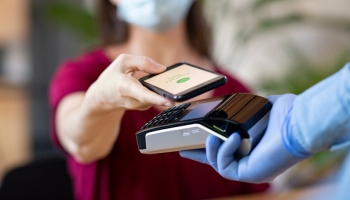How a Global Pandemic Will Affect Non-Cash Payments
Contactless and digital payments are set to experience significant growth in the coming years
- |
- Written by Banking Exchange staff

The volume of non-cash payments will grow by 12% a year for the next three years as the twin effects of the Covid-19 pandemic and economic recession hit, according to consultancy firm Capgemini.
The pandemic has forced governments to take measures to reduce face-to-face contact, leading to a significant rise in non-cash transactions such as online payments and contactless debt and credit card purchases.
However, Capgemini’s World Payments Report 2020 found that non-cash payments were already on the rise before the pandemic. Globally, such payments rose by 14% in 2018-19 to hit 708.5 billion transactions.
Half of consumers surveyed by Capgemini said they were using a challenger bank for at least some payments, while more than a third (38%) said they had discovered a new payment provider during lockdown.
Internet banking and direct account transfers are consumers’ preferred payment method, the research showed, selected by 68% of respondents. This was followed closely by contactless cards (64%) and digital wallets (48%).
“COVID-19 has accelerated the rate of innovation within the payments space to quickly form the ‘next normal,’ requiring payments firms to be digital masters almost overnight,” said Anirban Bose, CEO of Capgemini Financial Services. “Now more than ever, payments providers need to deliver differentiated offerings that emphasize speed, convenience, and a superb end-to-end customer experience.
“Currently, we are seeing visionary banks and payments firms diligently prioritizing technology transformation and actively adopting a ‘curate and collaborate’ approach by teaming with agile new players to create more nimble organizations.”
The research also found that digital wallet users were expected to jump from 2.3 billion in 2019 to 4 billion by 2024 – approximately half of the world’s population. ‘Invisible’, or automated, payments, used by services such as Amazon Go and Uber, were on course to grow by more than 50% a year between 2017 and 2022.
A separate study from Research And Markets, released in June, forecast that the global mobile payments market would grow to $12.4 trillion by 2025 – up from $3.7 trillion in 2019.
The increasing use of smartphones and government moves towards cashless economies were boosting this trend, the research showed, but variations in the quality of national banking and digital infrastructure would likely prove to be a headwind to growth.
A report from Allied Market Research, also published in June, forecast that the global mobile wallet market would hit $7.6 trillion by 2027, having stood at just over $1 trillion in 2019. This equated to a compound annual growth rate of 28.2% between 2020 to 2027, driven mainly by a soaring number of mobile subscribers worldwide and increased adoption of the mobile wallet as a digital payment business model.













